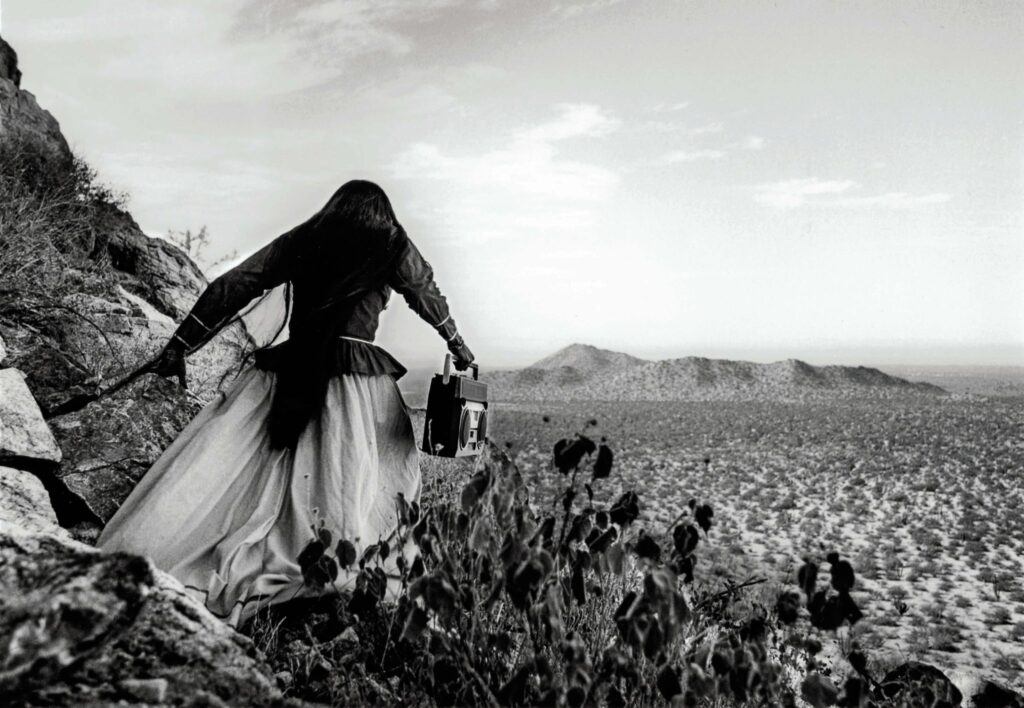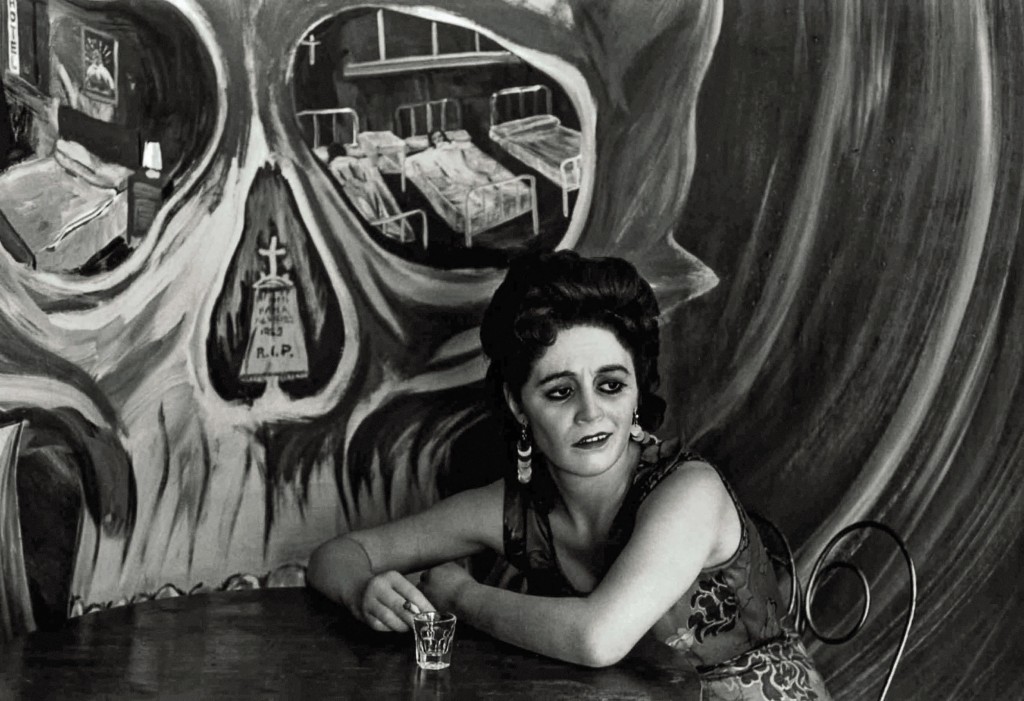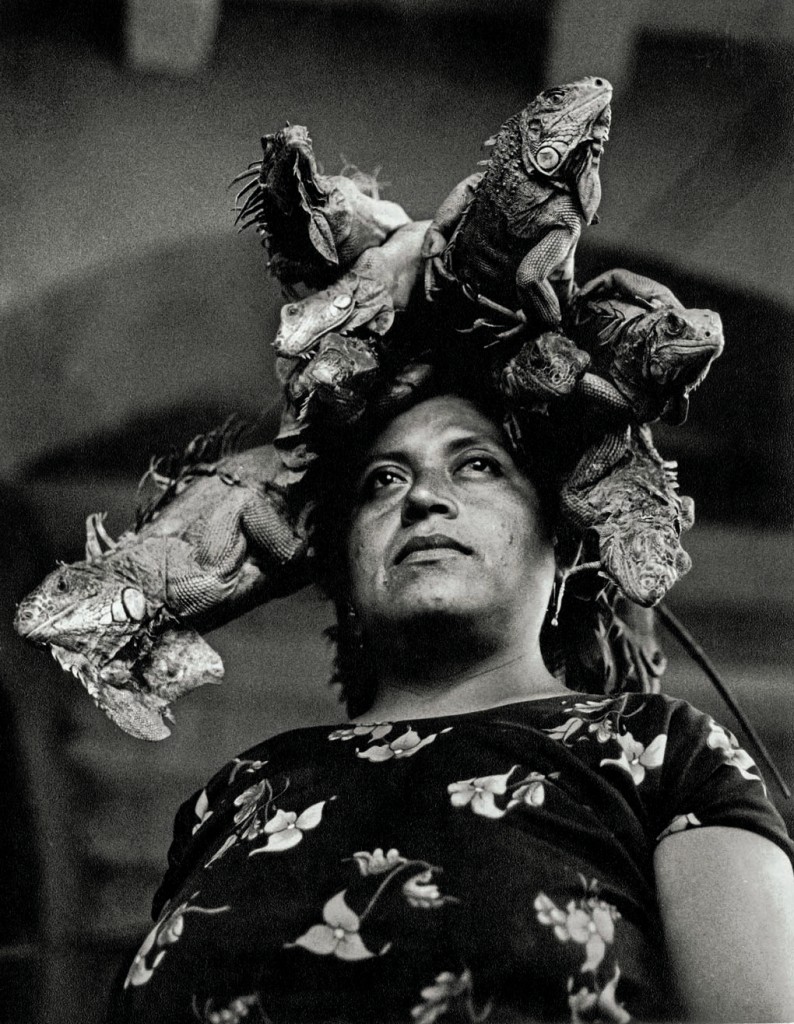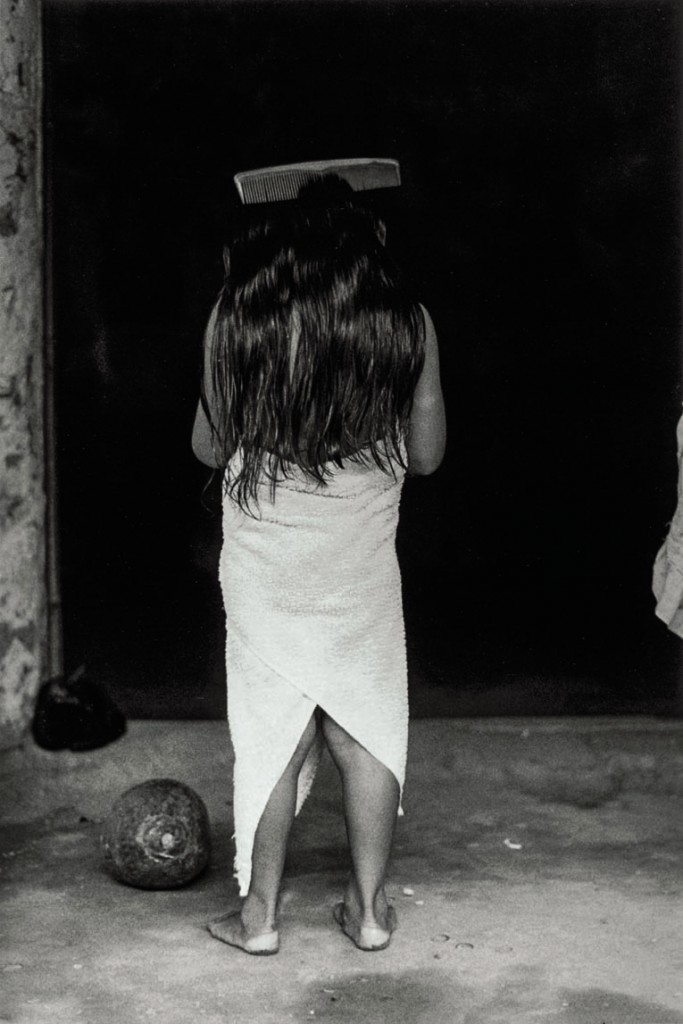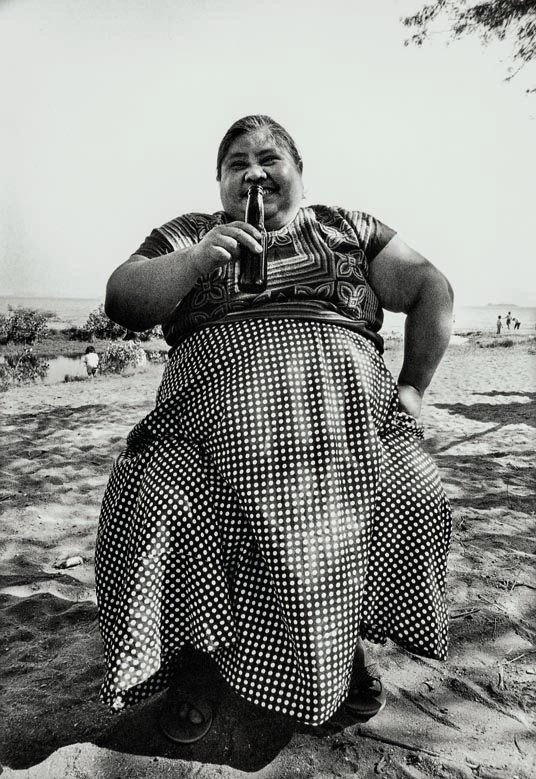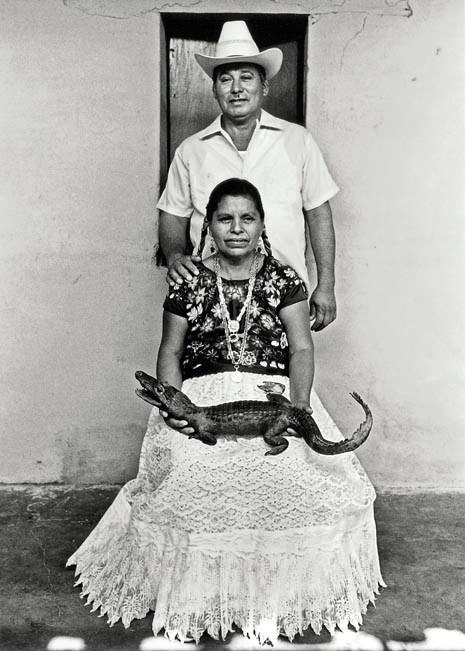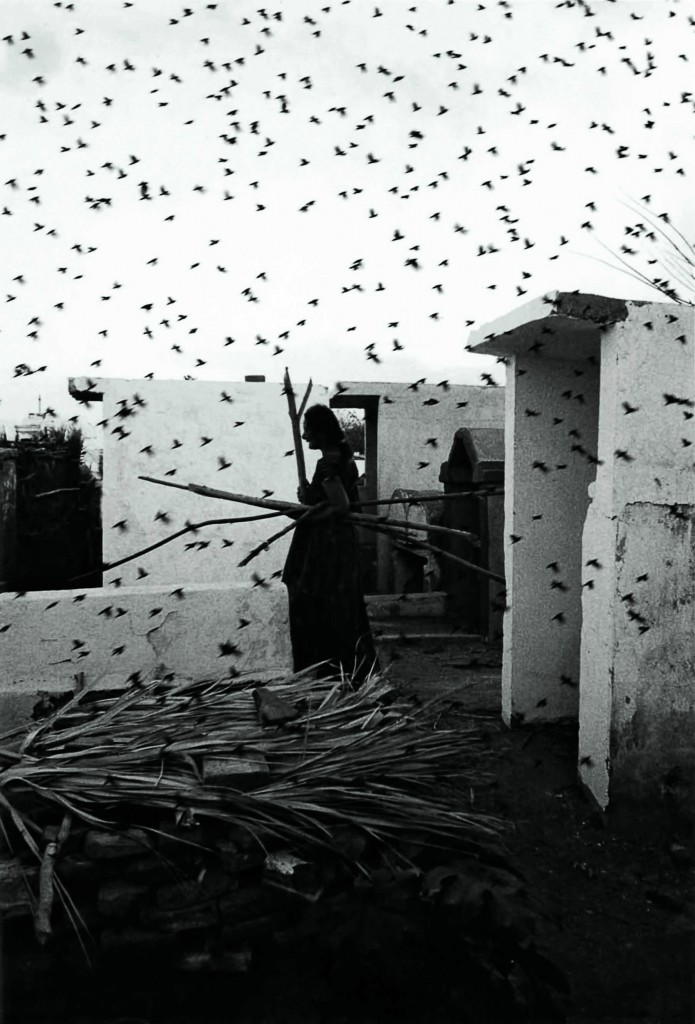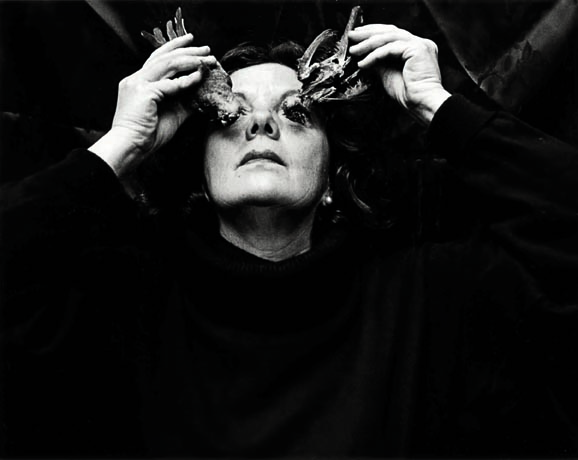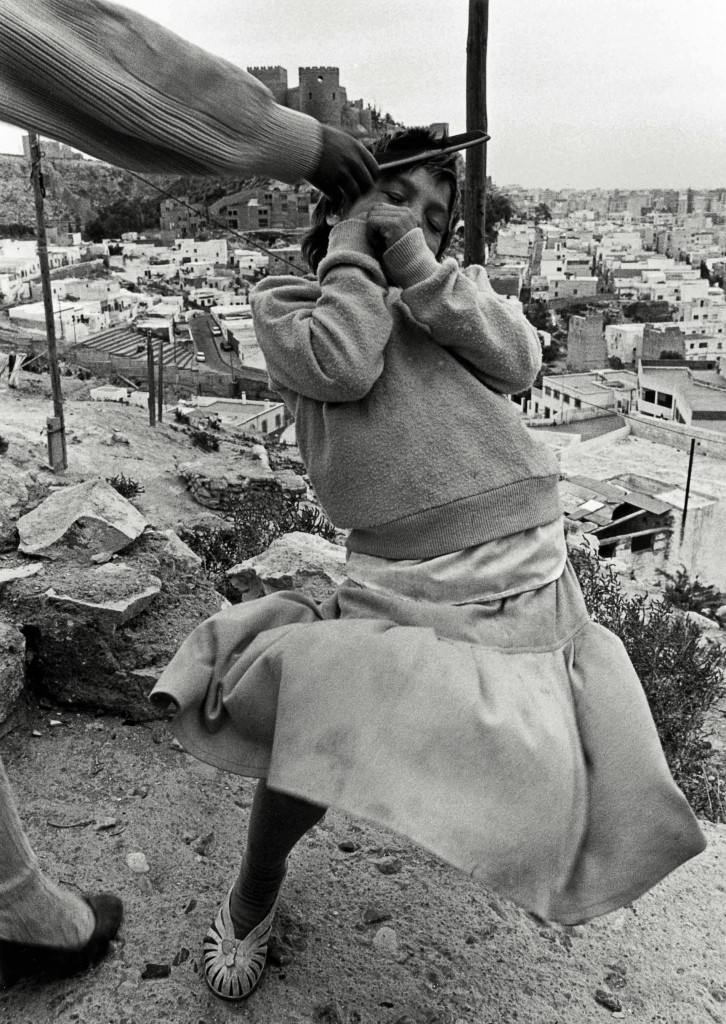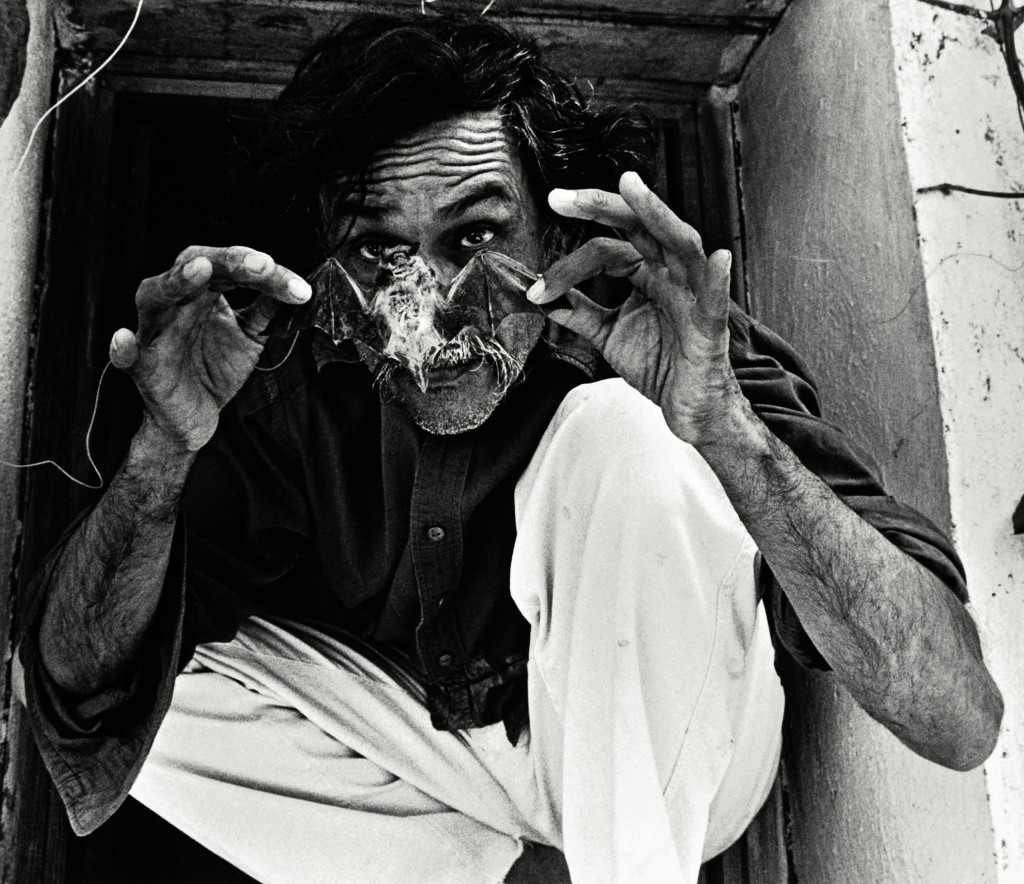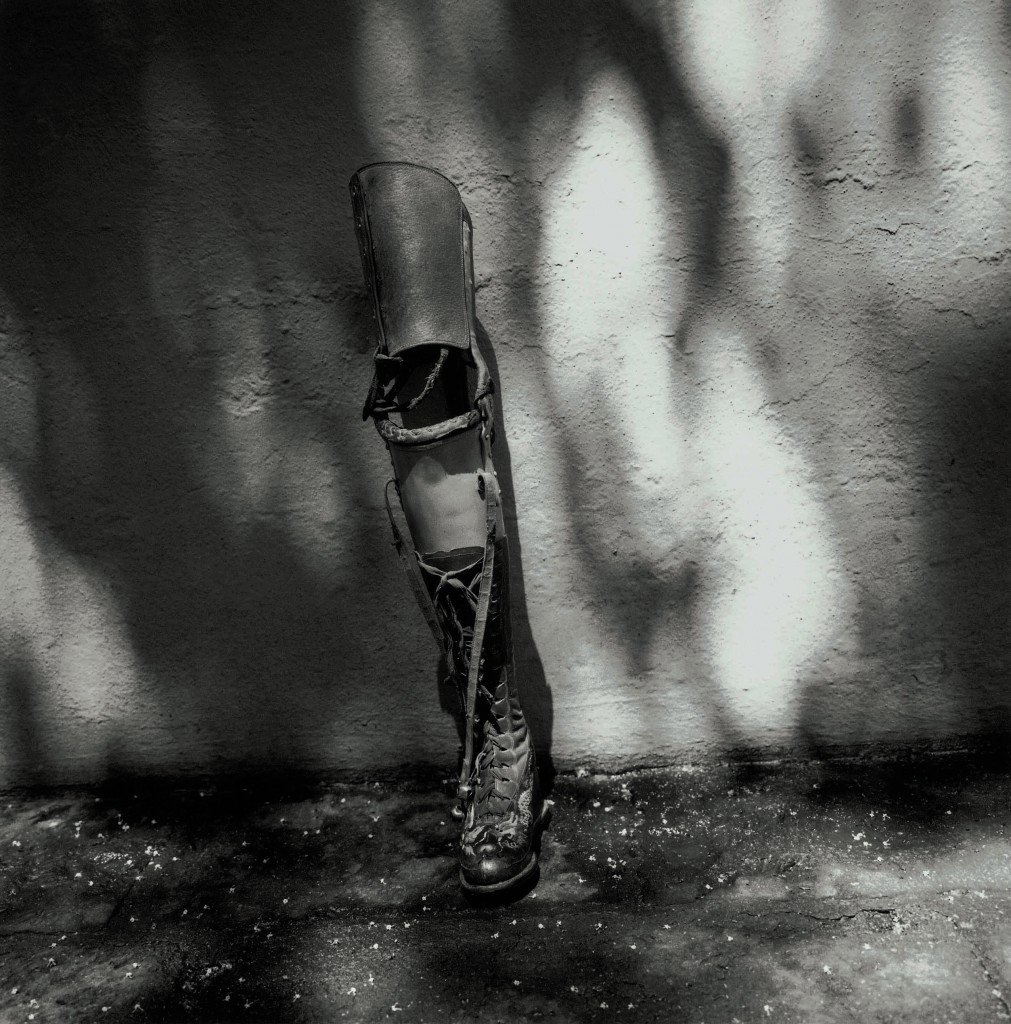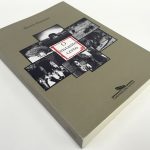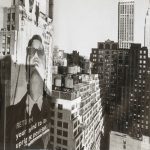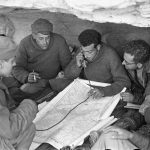Solitary Bird
Publicado em: 8 de March de 2016GRACIELA ITURBIDE’S lenses reveal a Mexico without clichés, in the slow pace of its indigenous culture, of desolate landscapes and of a unique surrealism.
The grande dame of Mexican photography is in no hurry. At 73, Graciela Iturbide continues her journey through life without haste. She likes to lend from Pablo Picasso a phrase to define her creative process: “I do not seek, I find.” She just picks up her camera for something worthy of a photograph to be shown in a different way. Something that awakens in her the desire to transform reality into a more personal vision.
This requires her to take things slowly. And it explains why some of her photo essays take five or even ten years to be completed. As noted by Marta Gili, director of the Parisian museum Jeu de Paume and author of Graciela Iturbide (Phaidon, 2010), if there is something that stares out of Iturbide’s images, it is time.
Her initiation into the métier came late. She had been married for eight years to the architect Manuel Rocha Diaz and was with three children when she decided to study film at UNAM, the National Autonomous University of Mexico. She changed direction when she met the professor Manuel Alvarez Bravo, the most important Mexican photographer of the 20th century.
With Alvarez Bravo, Iturbide learned to express herself through a camera. During a year and a half of going to his lectures, she was his achichincle – the apprentice who never ventures away from their master’s orbit. At the weekends, they made photographic forays into the fringes of Mexico City. She would watch Don Manuel: whenever he became interested in a landscape, he would stop the car, mount the camera on its tripod and wait. He was waiting for something to happen. Only that something was undefined. It might happen or it might not. It could take minutes or hours. A woman might move into the frame, a shadow might appear on the ground. Alvarez Bravo was in no hurry.
It wasn’t a coincidence that the master kept a motto displayed in the darkroom in his Coyoacan home: “There’s time, there’s time.” For things to go well, they had to be done calmly. Iturbide inherited this “poetics of patience” from him and incorporated it in her search for the sublime.
After drinking all that could be had from the font of Alvarez Bravo’s knowledge and experience, the disciple learned to see and portray the world with her own eyes. Instinctively and using her own talent, Iturbide never tried to imitate Don Manuel’s respected style. She doesn’t even use a tripod. She managed to cut the umbilical cord and take flight, without breaking the deep friendship that united them to the end.
When Don Manuel died in 2002 at the age of 100, Iturbide’s work was already to be found in major museums – including MoMA (New York), the Centre Georges Pompidou (Paris), SFMoMA (San Francisco), the J. Paul Getty Museum (Los Angeles), and the Victoria & Albert Museum (London). In April 2015, she received one of the awards that was still lacking – the prestigious Cornell Capa Lifetime Achievement Award from the International Center of Photography (ICP) in New York.
Since her debut with two breathtaking photo-essays, she has been hailed as a rare talent. Four decades later, she is one of the most important and influential photographers in Latin America.
Whenever Graciela Iturbide’s name comes up, the first image that springs to mind is that of a mysterious figure seen from the back, towering over the Sonora Desert: Mujer Ángel [angel woman], from 1979.
The photo is part of the artist’s first relevant photographic essay, on behalf of the ethnographic department of Mexico’s National Indigenous Institute (INI), which asked her to make a photographic mapping of a former nomadic people in the north of the country. Accompanied by the anthropologist Luis Barjau, Iturbide lived for a month and a half with the Seri people in the desert region of Punta Chueca, not far from the US state of Arizona. She recorded in her own way the adaptations of the traditional indigenous culture to the consumerism infiltrating from across the border.
The essay, entitled Los que Viven en la Arena [those who live in the sand], revealed a strong personal style and bewildered those who had been expecting a classic ethnographic study. The image of the Mujer Ángel completely overshadowed the original idea of the project and catapulted the artist to fame. While photography lovers celebrated the groundbreaking force shown by the newcomer Iturbide, anthropologists lamented the documentary vagueness of the captions, the emotional approach to the images, the artist’s lack of interest in scientific examination.
Even today, on occasion, Mujer Ángel raises questions about the veracity and realism of the scene depicted. The scene is said to have occurred during a trip into the depths of the desert that Iturbide and Barjau made in search of prehistoric paintings in a cave. The somewhat ghostlike figure in the photo was a Seri who was acting as their guide; the radio in her hand was probably the result of bartering craft items with some Arizonian redneck.
Iturbide said that she developed the film and examined the contact sheets without noticing the image that would become famous. From then on, her story becomes rather confusing. The photographer either doesn’t remember how or when she shot the image, or she doubts if she herself took it. “I think it was a gift that the desert gave me,” she sums up. “I called her Mujer Ángel as she gave the impression of being able to fly away into the desert.”
This attempt to apply the criteria of photojournalism to one of her rare images of a figure in motion ends up being of little use. The value of the image is something else. As is the case with the criteria that govern the entire work of Iturbide, whom Oscar Colorado Nates, a professor at Panamerican University, in Mexico City, names the “señora de los simbolos” [lady of symbols].
Nor does it matter if the six live iguanas occupying the top of the head of a Juchitan woman – perhaps the second best known of her photographs – were or were not carefully arranged so that the photographer could immortalize the scene. “I’m not an anthropologist or a sociologist. I shoot photos for the pleasure of it, I never photograph anything just to document it,” Iturbide repeats to exhaustion.
The woman in the famous portrait, which is named Nuestra Senõra de las Iguanas [Our Lady of the iguanas] (1979), was big-boned and fleshy, like most of her people. Her name was Zobeida and she was on her way to the market to sell the goods she was carrying on her head when she was intercepted by Iturbide’s camera.
Zobeida and the women of the Zapotec people had a significant impact on the life and work of the photographer. Newly returned from her tribal baptism with the Seris in the desert, she received a tempting invitation from Francisco Toledo, the most celebrated Mexican painter and artist to the present day. A militant by nature and a humanist by training, Toledo wanted to give national visibility to what remained from the indomitable Zapotecs, who lived in the extreme south of Mexico. Himself a native of the region, he was alarmed that there were no images good enough to record that human heritage.
And that is how Iturbide, who until then had been a member of the urban elite in Mexico City, landed in Juchitan, on the remote isthmus of Tehuantepec, and found there a vibrant matriarchal society that elated her.
She herself described how intimate were the ties that marked her pioneer work: “They are strong women, physically large, politicized, emancipated, and wonderful. I discovered the world of women. I lived in their houses. They adopted me. They let me in to their daily lives and traditions. They told erotic tales, joking all the time. They taught me the aphrodisiac properties of the lizard, known to few outside the isthmus. Not only did they allow me to photograph them, but they also took the initiative to show me things. I began to describe Juchitan through their eyes as well as mine.”
Juchitan has been described as a mythical place where a man finds his origin, and a woman, her deepest essence. “In Juchitan,” wrote the folk art historian and caricaturist Miguel Covarrubias, “there is none of the evasive behavior or servile humility that characterizes other indigenous peoples, whose strength of character has been undermined by direct repression from the same social class.” The description of the Zapotec society by writer and journalist Elena Poniatowska, winner of the Miguel de Cervantes Prize in 2013, is far more uninhibited. Her remarkable essay for the book Juchitán de las Mujeres [Juchitan of the women] begins: “In Juchitan, Oaxaca, men do not know what to do with themselves except to put themselves inside women. Children hang from their mothers’ breasts while the iguanas observe the world from the top of their heads. In Juchitan, trees have a heart and men have sweet or salty penises, depending on your taste. Women are very proud of being female, because they carry their redemption between their legs and give everyone the death they desire. They call making love ‘little death.’”
Iturbide found herself in a place where it was the women who held the power over money. They were the only ones to run the market, fix the prices and bargain on the market square, all the while they looked after the home, decided on family matters and were responsible for religious observances. A man was supposed to get up early to hunt, gather and fish, and at the end of their toil only deliver what they succeeded in catching. In Juchitán de las Mujeres, the splendid photo essay that shot her to the top of her métier, Iturbide managed to do it all: she captured the shameless sense of humor, the assertive nudity, the physical and uninhibited strength of a Mexican womanhood of which the Mexicans themselves were unaware.
When Western feminism gathered power in the 1980s, the publication of the essay was received with a frisson. And it did not take long for the image of the señora, with her confident look and iguanas on her head, to be absorved into the gallery of the movement’s symbols. Visits by activists from England and Japan to interview Zobeida in Juchitan only deepened the misunderstanding. They asked her if she was a feminist. She replied “yes” – referring to the fact that she was a widow and was forced to sustain herself alone. “That is how myths are created,” the author of the famous portrait said some time later.
Stanley Brandes, Professor at the University of California at Berkeley and a well-known authority on visual anthropology, popular religions and folklore, made an interesting observation on the series of photographs of indigenous peoples that Iturbide took in Mexico (besides the Seris and Zapotecs of the isthmus, she also photographed the Mixtecs). In a 2008 essay, published in Visual Anthropology Review, Stanley Brandes says: “Graciela Iturbide, whose photographic corpus is intimately personal and whose goal is primarily aesthetic, fails to conform to scientific paradigms. […] But I would say that Graciela Iturbide is, in fact, an ‘innate anthropologist.’ Her photographic subjects are the same kind of people who anthropologists most study: indigenous peoples, marginal or forgotten groups and, foremost, women. […] And yet her portraits, despite having insufficiently clear captions or providing insufficient data, provide rich etnografic information. […] To her, photography has become a form of therapy, the means by which she can transcend her immediate life circumstances and show her audience a Mexico that even we, anthropologists, vaguely imagined to exist.”
The “life circumstances” referred to by Brandes struck Iturbide when she was 28. Just before leaving for Juchitan, a disease robbed her of her six-year-old daughter Claudia, soon followed by the separation from her husband. It was the beginning of a long journey into the night. During the next five years, she obsessively frequented village cemeteries to photograph the always ritualized funerals of angelitos [little angels].
Iturbide herself, when she was a school girl, studied in a boarding school run by nuns and grew up enraptured by some of the school’s rituals – dressing up as an angel, receiving a crown of laurel leaves at graduation, playing the role of the Virgin on stage. Like her countrymen, she has been aware, since she was a child, of the cult of death that pervades Mexico. “I think we are so afraid of death that we have become a people dedicated to celebrating it,” she says.
Unlike the funereal and tearful way the rest of the world marks November 2 (All Souls’ Day), in Mexico, the Day of the Dead is a colorful and noisy celebration that lasts two days, in which the country celebrates a visit by the souls of angelitos who have died and prepare the favorite drink of adults who have passed away, so that the living play because they are alive.
Having lost a daughter, death was truly too much for Iturbide. She admits that it is still difficult to talk about the subject today, even after a quarter-century has passed. In contrast, when Iturbide wields her camera, death finds a generous shelter and is given full expression throughout her work.
In an interview with the writer Fabienne Bradu, Iturbide sums up her relationship with her craft: “Photography is not the truth. It is the photographer who interprets reality and reconstructs it according to their emotions and knowledge. Without the camera, you see the world in one way. Through the lens, you synthesize what you are and what you have learned. Deep down, you’re always taking your own portrait. You are interpreting.”
The masterful series of photographs of birds by Iturbide, perhaps her most beautiful set of images because it is disturbing, portrays this rending. She sees them sometimes as messengers of death, sometimes as guardians. Almost always, she photographs them in flight or in flocks – sometimes in such a tight formation that they seem to swallow up the sky.
The artist finds refuge in the company of “Solitary Bird”, a text by the Spanish priest Saint John of the Cross that she always has at hand. She admits she recognizes in herself the five characteristics that the author attributes to the solitary bird – it flies higher than the others, tolerates no company, not even that of its peers, points its beak into the wind, sings softly, and is of a nondescript color so as not to call attention. Perhaps this is indeed a good definition of Iturbide: a solitary bird.
“I do not believe in anything,” she says. She has no religious faith. What delights her are the rituals, the sacred, the mystical, the moments laden with meaning. In the documentary Hay Tiempo [there is time] (2007), directed by Alejandro Gomez de Tuddo for the J. Paul Getty Museum, she narrates the tender tale of her first trip to Rome, full of symbolism and hidden signs. She said she was with a friend in Piazza Mattei, contemplating the Turtle Fountain, when she noticed an inscription of only two words on a small plate: festina lente. Many decades had passed since she took up photography, and suddenly, everything made sense: these two Latin words mean “make haste slowly.” It was exactly what she had learned from Don Manuel Alvarez Bravo early in her career and recalled the note in his darkroom – “There’s time.”
Other things are less easy to decipher or explain, even by the photographer herself. That is the case with most of her self-portraits. Iturbide regularly takes photographs of herself. Compositions that, she says, stem from unconscious urges. She gives as an example a photo in which she is resting her head on the floor and her eyes are covered by two birds. A fleeting idea had occurred to her days before: she needed a bird. She didn’t ask herself what for or why. From there on, the rest happened at its own pace. She first got hold of a live bird, then a dead one and placed them both on her face, thinking of the title: Ojos para Volar? [eyes to fly with?].
Other self-portraits show her standing, with a fish covering her mouth, or with a snail glued to her face, or with snakes dripping from her lips. Iturbide prefers not even to try to interpret the images: “Nothing is planned, they are flashes that come to my imagination and contain the essence of what I am – for good or for bad.”
Not just her self-portraits contain images that seem to have come out of a fragmented dream, stolen from a narrative and with distortions of scale that create a sense of unease. They are photographs which don’t have a definition of time or space: an enormous ostrich standing immobile at a road junction, many clocks without hands stuck on a tree trunk, trees covered by black cloths, reminiscent of hooded hostages.
Iturbide’s communion with nature can be seen in the way she describes a visit to the Botanic Garden in Oaxaca. Instead of focusing on the most beautiful plants, she targeted those being cared for: “There were plants covered in veils, others held up by crutches, while others were suffering from being tied up. I went during a period when I was sad, so I photographed the plants that were sick, covered in bandages, needing to recover.”
As much as one wants to be able to identify influences in her work, or at least intersections with it, it is safer to confine oneself to citing photographers who Iturbide admires rather than to discover direct inspirations. Her preferences are known and eclectic, as they range from the Frenchman Jacques-Henri Lartigue to the Swedish Christer Stromholm and the Americans Edward Weston and Francesca Woodman. She has a particular fascination for the work of the Hungarian Brassai. From Alvarez Bravo, she has inherited an admiration for the Surrealists, and she shows a special respect for Josef Koudelka, as she has yet to publish her photographs of the gypsies in Almeria on the grounds that the work of the Czech photographer on the subject is so accomplished and definitive that it would be disrespectful to do so. Nor has she published her photographs from the 1970s of rundown circuses (“I am enchanted by the loneliness of that life”), as she also respects the work of Mary Ellen Mark. “Someday, maybe,” says Iturbide.
One of the reasons that has led her to cross photographic borders and seek to express herself through objects and landscapes, rather than more human portraits, was to free herself of the iconic images from early in her career, which have overshadowed her other work. And to follow her on this creative journey, nothing has had more impact than the collection of 101 square-format photographs in the book Asor, 2009. It is not easy to unravel this work. The images come without any text to point you in a direction; there is no preface, introduction, presentation or afterword. The photos are undated and have no title or caption. They hang alone on the page and do not portray people. The only human presence on this trip without a script is the reader.
In contrast, in another of her photographic essays without any human figure, an extraordinary woman is present throughout. The essay is the result of an encounter between two Mexican women who never actually met: Graciela Iturbide and Frida Kahlo.
Ten years ago, the authorities responsible for the cultural heritage of Kahlo agreed to open up to the public a bathroom in the painter’s famous Blue House, which had remained closed up since her death in 1954. As far as her husband, the muralist Diego Rivera, was concerned, the bathroom and the orthopaedic paraphernalia it contained should never be exposed to the curiosity of the world. To ensure Kahlo’s posthumous privacy, Rivera decided that the room should remain sealed.
Kahlo, besides having contracted polio when she was six and having a resulting limp, suffered a serious accident when she was eighteen and went through over thirty surgeries (seven in the spine), wore orthopaedic braces to withstand the excruciating pain and had to have a leg amputated two years before she died.
Five decades afterwards, however, access was eventually granted. And it fell to Iturbide to document the private world of the Blue House. She opted for something more daring: to make a portrait of Kahlo using what could be seen in the painter’s most private and solitary refuge, her bathroom. Thus were born the 21 images that make up the extraordinary essay El Baño de Frida [Frida’s bathroom].
The bathroom was where Frida came face to face with her pain and her twisted body. Instead of the colorful skirts, blouses and ornaments with which she was always covered, the painter had there, hanging on hooks, her various medieval-like orthopaedic corsets, the crutches and the medical equipment.
Iturbide found the right language to portray this private hell and reveals Kahlo to the viewer without her actually being present. It is as if we are seeing and understanding her for the first time. The painter’s artificial leg, photographed propped up against a wall of the house, as if calling its owner to the life outside the bathroom, depicts an abysmal melancholy.
Iturbide has lived for more than two decades in the same house in the Barrio del Nino Jesus, in Coyoacan, where she moved following the advice of Alvarez Bravo. It is an enclave in Mexico City, where humble families live alongside artists looking for quiet. One of her most loved visitors is the same Francisco Toledo who had asked her to portray the Zapotecs and who went on to become friends with her for life. The overflowing personality of the Oaxacan painter gave birth to a playful complicity between them and he has served as a safe haven for Iturbide ever since.
Iturbide, for whom the camera has become a way for her to see the world and the inside of herself, has extended the concept of documentary photography. As the Hasselblad Foundation said when awarding her work, Iturbide explores the relationship between man and nature, the individual and culture, the real and the psychological.
Iturbide sums up in a nutshell how she sees life and the essence of all her work: “We came into the world to dream, that’s all. And, one day, to go to the other side.” ///
captions: Mujer Ángel [angel-woman], Sonora Desert 1979; Mexico City, 1969; Nuestra Senõra de las Iguanas [Our Lady of the iguanas], Juchitán, Oaxaca, 1979; La Niña del Peine [girl with hair-comb], Juchitán, Oaxaca, 1979; Fiesta del Lagarto [festival of the lizard], Juchitán, Oaxaca, 1986; Padrinos del Lagarto [lizard godparents], Juchitán, Oaxaca, 1986; Magnolia, Juchitán, Oaxaca, 1986; Cementerio [cemetery], Juchitán, Oaxaca, 1988; Ojos para Volar? [eyes to fly with?], Coyoacán, 1991; Gitana [gipsy], Almería, Spain, 1991; Francisco Toledo, Oaxaca, 1997; Frida Kahlo’s prosthetic leg, Coyoacán, 2006
images: © Graciela Iturbide
+
Asor, by Graciela Iturbide (Steidl, 2009);
Conversaciones con Fotógrafos – Lo Real (La Fabrica, 2010);
Graciela Iturbide: Juchitán de las Mujeres 1979-1989 (RM, 2010);
Graciela Iturbide, by Marta Gili (Phaidon, 2010);
Hay Tiempo, documentary by Alejandro Gómez de Tuddo (Getty Museum, 2007)
Graciela Iturbide (1942), photographer, studied at the National Autonomous University of Mexico, in the Center for Film Studies. She is the author of Juchitán de las Mujeres 1979-1989 [Juchitan of the women]. In 2015, she received the Cornell Capa Award from the International Center of Photography (ICP) in New York.
Dorrit Harazim (1943) is a journalist and former columnist for the ZUM website. She received the Gabriel García Márquez Journalism Award in 2015.
///
Get to know ZUM’s issues | See other highlights from ZUM #9 | Buy this issue


